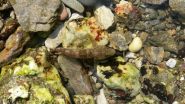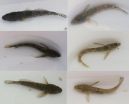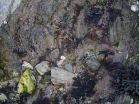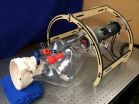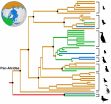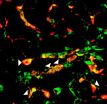(Press-News.org) Research from the University of Exeter has revealed that the rock goby (Gobius paganellus), an unassuming little fish commonly found in rock pools around Britain, southern Europe, and North Africa, is a master of camouflage and can rapidly change colour to conceal itself against its background.
Whether hiding from predators or from families hunting in rock pools, the rock goby can change both its colour and brightness to match its background in just one minute.
Dr Martin Stevens from the Centre for Ecology and Conservation at the University of Exeter's Penryn Campus in Cornwall said: "Anyone who's been rock pooling will probably have encountered rock gobies, and may even have thought they could see them change colour in buckets. Our research shows that this is the case and that rock gobies can rapidly tune their appearance to match their background."
The researchers found that when gobies were photographed on a bright white or dark background, they could change their brightness accordingly. When photographed on coloured backgrounds they altered their colour, becoming either more red or blue.
Undertaking this rapid visual change should be a major advantage for the fish when trying to avoid predators. Gobies find themselves under intense predation pressure at low tide from birds and at high tide from larger fish. To remain concealed they must rapidly respond as they are pushed over many different backgrounds by tides and waves.
The researchers collected the gobies from Gyllyngvase beach in Falmouth, Cornwall then photographed them against different backgrounds over time to quantify the speed and extent of the colour change. The results show that the fish were capable of rapid visual change for concealment.
The colour change is driven by special cells in the fishes' bodies called 'chromatophores'. These are found in many animals and work to condense or spread pigments of different colour over the body, changing the appearance of the fish. This process is guided by the visual system of the goby when it moves onto a new background.
Studies of colour change for camouflage have previously been undertaken in animals including chameleons, cuttlefish, flatfish, and crabs, but rarely have studies directly quantified the changes in colour and brightness that occur, how fast this happens, and how they affect camouflage matching.
INFORMATION:
The research was supported by the Biotechnology and Biological Sciences Research Council.
The research paper: Rockpool gobies change colour for camouflage by Martin Stevens, Alice E. Lown, and Alexander M. Denton is published in the journal PLOS ONE.
About the University of Exeter
The University of Exeter is a Russell Group university and in the top one percent of institutions globally. It combines world-class research with very high levels of student satisfaction. Exeter has over 19,000 students and is ranked 7th in The Times and The Sunday Times Good University Guide league table, 10th in The Complete University Guide and 12th in the Guardian University Guide 2014. In the 2008 Research Assessment Exercise (RAE) 90% of the University's research was rated as being at internationally recognised levels and 16 of its 31 subjects are ranked in the top 10, with 27 subjects ranked in the top 20. Exeter was The Sunday Times University of the Year 2012-13
The University has four campuses. The Streatham and St Luke's campuses are in Exeter and there are two campuses in Cornwall, Penryn and Truro. In a pioneering arrangement in the UK, the Penryn Campus is owned and jointly managed with Falmouth University. At the campus, University of Exeter students can study programmes in the following areas: Animal Behaviour, Conservation Biology and Ecology, English, Environmental Science, Evolutionary Biology, Geography, Geology, History, Human Sciences, Mathematics and the Environment, Mining and Minerals Engineering, Politics and International Relations, Renewable Energy and Zoology.
The University has invested strategically to deliver more than £350 million worth of new facilities across its campuses in the past few years; including landmark new student services centres - the Forum in Exeter and The Exchange at Penryn – together with world-class new facilities for Biosciences, the Business School and the Environment and Sustainability Institute. There are plans for another £330 million of investment between now and 2016.
http://www.exeter.ac.uk/cornwall
For further information:
Jo Bowler, Science Press Officer
j.bowler@exeter.ac.uk
Office: +44(0)1392 722 062
Mobile: +44(0)7827 309 332
Twitter: @UoE_ScienceNews
For urgent enquiries outside nomal office hours please ring +44(0)7789 942 505 or email pressoffice@exeter.ac.uk
Researchers solve riddle of the rock pools
Study shows rock gobies use rapid color change camouflage to hide from predators
2014-10-15
ELSE PRESS RELEASES FROM THIS DATE:
Poor quality data is informing the future of our patient care, warns study
2014-10-15
An investigation into how patient outcomes are assessed in clinical trials has revealed a worrying lack of consistency, raising concerns about funding being wasted on the acquisition of poor quality data.
Information collected through clinical trials plays a crucial role in improving the standard of patient care. Patient Reported Outcomes (PROs) inform our understanding of how certain treatments and interventions work by evaluating their effectiveness, and any potential side effects, from the patient perspective.
Patients in trials are commonly invited to fill in questionnaires ...
Could sleeper sharks be preying on protected Steller sea lions?
2014-10-15
NEWPORT, Ore. – Pacific sleeper sharks, a large, slow-moving species thought of as primarily a scavenger or predator of fish, may be preying on something a bit larger – protected Steller sea lions in the Gulf of Alaska.
A new study found the first indirect evidence that this cold-blooded shark that can grow to a length of more than 20 feet – longer than a great white shark – may be an opportunistic predator of juvenile Steller sea lions.
Results of the study have just been published in the journal Fishery Bulletin. The findings are important, ...
Milky Way ransacks nearby dwarf galaxies
2014-10-15
Astronomers using the National Science Foundation's Green Bank Telescope (GBT) in West Virginia, along with data from other large radio telescopes, have discovered that our nearest galactic neighbors, the dwarf spheroidal galaxies, are devoid of star-forming gas, and that our Milky Way Galaxy is to blame.
These new radio observations, which are the highest sensitivity of their kind ever undertaken, reveal that within a well-defined boundary around our Galaxy, dwarf galaxies are completely devoid of hydrogen gas; beyond this point, dwarf galaxies are teeming with star-forming ...
Getting to know super-earths
2014-10-15
"If you have a coin and flip it just once, what does that tell you about the odds of heads versus tails?" asks Heather Knutson, assistant professor of planetary science at Caltech. "It tells you almost nothing. It's the same with planetary systems," she says.
For as long as astronomers have been looking to the skies, we have had just one planetary system—our own—to study in depth. That means we have only gotten to know a handful of possible outcomes of the planet formation process, and we cannot say much about whether the features observed in our solar system ...
Brain surgery through the cheek
2014-10-15
For those most severely affected, treating epilepsy means drilling through the skull deep into the brain to destroy the small area where the seizures originate – invasive, dangerous and with a long recovery period.
Five years ago, a team of Vanderbilt engineers wondered: Is it possible to address epileptic seizures in a less invasive way? They decided it would be possible. Because the area of the brain involved is the hippocampus, which is located at the bottom of the brain, they could develop a robotic device that pokes through the cheek and enters the brain from ...
Why me? Many women living in poverty blame children, love life
2014-10-15
Having had children – particularly early in life – and a dysfunctional romantic relationship are the two most frequently cited reasons when low-income mothers are asked about why they find themselves in poverty. So say American researchers Kristin Mickelson of the School of Social and Behavioral Sciences at Arizona State University, and Emily Hazlett of Kent State University and the Northeast Ohio Medical University, in a new article published in Springer's journal Sex Roles. The researchers believe that how a woman answers the question of "why me?" when thinking ...
A canary for climate change
2014-10-15
Modern-day puffins and auks have long been recognized as environmental indicator species for ongoing faunal shifts, and fossil records now indicate that ancient relatives were similarly informative. Researchers have found that puffins and auks may have been at their most diverse and widespread levels during a relatively warm period of Earth's history. The results also explain how past extinctions have shaped the geographic distribution and population size of existing species.
Authors Adam Smith of the National Evolutionary Synthesis Center (NESCent) in Durham, N.C., and ...
A global natural gas boom alone won't slow climate change
2014-10-15
COLLEGE PARK, Md. – A new analysis of global energy use, economics and the climate shows that without new climate policies, expanding the current bounty of inexpensive natural gas alone would not slow the growth of global greenhouse gas emissions worldwide over the long term, according to a study appearing today in Nature.
Because natural gas emits half the carbon dioxide of coal, many people hoped the recent natural gas boom could help slow climate change—and according to government analyses, natural gas did contribute partially to a decline in U.S. carbon ...
Natural gas boom will not slow climate change
2014-10-15
This market effect erases the advantage of lower emissions from the natural gas itself, according to an unprecedented international comparison of computer simulations.
"The upshot is that abundant natural gas alone will not rescue us from climate change," says the lead author Haewon McJeon of the Department of Energy's Pacific Northwest National Laboratory (PNNL). Especially in the US advances such as hydraulic fracturing – pumping liquids into stone to break it up and release the gas, known as fracking – and horizontal drilling have led to bountiful natural ...
Discovery of heart's repair process suggests new treatment strategy for heart attack
2014-10-15
UCLA researchers have discovered that some scar-forming cells in the heart, known as fibroblasts, have the ability to become endothelial cells — the cells that form blood vessels. The finding could point the way toward a new strategy for treating people who have suffered a heart attack, because increasing the number of blood vessels in the heart boosts its ability to heal after injury.
In studies involving mice, the UCLA team also found that a drug could enhance this phenomenon and improve the repair process after a heart attack.
The research is published in the ...
LAST 30 PRESS RELEASES:
Sports injuries sustained during your period might be more severe
World's first successful 2 Tbit/s free-space optical communication using small optical terminals mountable on satellites and HAPS
Can intimate relationships affect your heart? New study says ‘yes’
Scalable and healable gradient textiles for multi‑scenario radiative cooling via bicomponent blow spinning
Research shows informed traders never let a good climate crisis go to waste
Intelligent XGBoost framework enhances asphalt pavement skid resistance assessment
Dual-function biomaterials for postoperative osteosarcoma: Tumor suppression and bone regeneration
New framework reveals where transport emissions concentrate in Singapore
NTP-enhanced lattice oxygen activation in Ce-Co catalysts for low-temperature soot combustion
Synergistic interface engineering in Cu-Zn-Ce catalysts for efficient CO2 hydrogenation to methanol
COVID-19 leaves a lasting mark on the human brain
Scientists use ultrasound to soften and treat cancer tumors without damaging healthy tissue
Community swimming program for Black youth boosts skills, sense of belonging, study finds
Specific depressive symptoms in midlife linked to increased dementia risk
An ‘illuminating’ design sheds light on cholesterol
Who is more likely to get long COVID?
Study showcases resilience and rapid growth of “living rocks”
Naval Research Lab diver earns Office of Naval Research 2025 Sailor of the Year
New Mayo-led study establishes practical definition for rapidly progressive dementia
Fossil fuel industry’s “climate false solutions” reinforce its power and aggravate environmental injustice
Researchers reveal bias in a widely used measure of algorithm performance
Alcohol causes cancer. A study from IOCB Prague confirms damage to DNA and shows how cells defend against it
Hidden viruses in wastewater treatment may shape public health risks, study finds
Unlock the power of nature: how biomass can transform climate mitigation
Biochar reshapes hidden soil microbes that capture carbon dioxide in farmland
Reducing saturated fat intake shows mortality benefit, but only in high-risk individuals
Manta rays create mobile ecosystems, study finds
Study: Mixed results in using lipoic acid to treat progressive multiple sclerosis
Norbert Holtkamp appointed director of Fermi National Accelerator Laboratory
New agentic AI platform accelerates advanced optics design
[Press-News.org] Researchers solve riddle of the rock poolsStudy shows rock gobies use rapid color change camouflage to hide from predators
